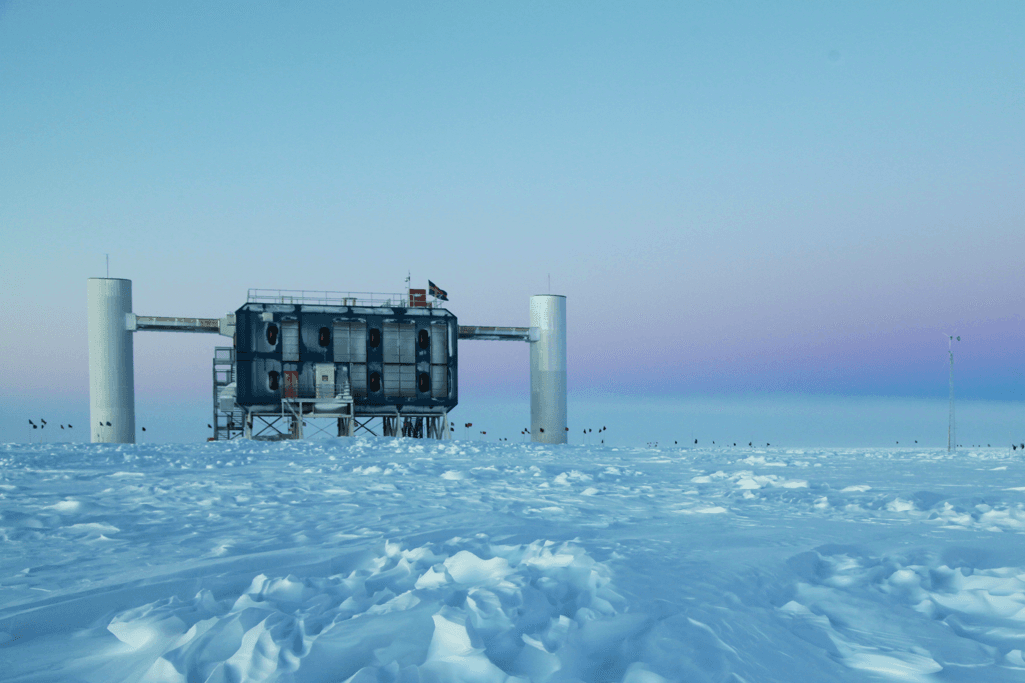Neutrinos: A little-noticed breakthrough lets scientists see the distant cosmos like never before
The IceCube Laboratory at the Amundsen-Scott South Pole Station, in Antarctica.
PORTLAND, Maine — Imagine being one of the very first humans, tens of thousands of years ago, to actually look up at the night sky. You’d see dozens of lights and other sights, with no understanding of what they were, where they were, or anything else. You might think they were just “pinholes in the curtain of night.”
Only after centuries of study, with the invention of countless increasingly complex devices to peer into the sky, can we say we know anything at all about planets, stars, galaxies, and the universe as a whole.
But a recent scientific discovery has brought us back to that very first night: to the very beginning of our exploration, and to the realization of just how rudimentary our knowledge is.
After decades of searching, scientists have detected high-energy subatomic particles originating from previously unknown sources in the universe.
The particles themselves aren't news. Neutrinos — nearly massless, charge-less byproducts of radioactive decay — were first theorized in 1930 and first detected in 1956 during nuclear experiments on Earth.
Since then, we have learned that neutrinos are literally everywhere. In the time it takes to read this sentence, about 700 trillion of them run through your body. Almost all of the neutrinos scientists have detected originated either from the Sun, from the Earth’s atmosphere, or from man-made nuclear activities.
However, an almost impossibly tiny proportion come from the far reaches of the universe. Tracing those neutrinos' movements offers the possibility of greatly expanding our understanding of the cosmos.
For more than a decade, a research project called IceCube has sought to do just that — to detect neutrinos from outside our galactic neighborhood, using a cubic-kilometer detector embedded in the Antarctic ice sheet.
A paper published in the journal Science revealed late last year that IceCube had detected 28 of the particles.
And that’s rocked the physics world.
These minuscule particles from distant sources are analogous to the light emitted by the first stars ever seen by human eyes.
Because they are so tiny and electrically neutral, neutrinos “can travel at nearly the speed of light from the edge of the universe without being deflected by magnetic fields or absorbed by matter,” according to IceCube’s explanatory webpage.
Most vitally, “they travel in straight lines from their source,” which means when we "detect them here on Earth, we can calculate where they came from, like a laser pointer aimed back out into space,” said Francis Halzen, a physicist at the University of Wisconsin-Madison, who directs IceCube.
“At the moment we don’t know what we’re mapping,” he added.
Still, the accomplishment is significant, in that it may lead to the discovery of more distant parts of the cosmos than we have ever known. It could even lead to new fields of physics. Some scientists suspect these extra-galactic neutrinos may be able to tell us more about the heretofore invisible “dark matter” that many believe makes up most of the mass of the universe.
Very high-energy neutrinos, like the 28 detected by IceCube, are as much as billion times more energetic than those commonly found here on Earth. They are thought to come from supernovas and black holes, but nobody is sure yet.
“The energy requirements of these sources are so large” that theorists’ imaginations are being stretched to come up with possible explanations, Halzen said. “We are really looking at the violent processes” of the universe.
Halzen has spent most of his career searching for neutrinos and trying to explain their origins, and not even he knows what we’ll find.
IceCube is only the first glance from the first “eye” ever to look at the sky in this way. “It’s like a map of the universe with 28 pixels,” he said. “That’s a lot of emptiness.”
Finding even these few neutrinos has taken decades of innovation and science. As far back as the 1970s, Halzen said, it was clear that finding high-energy neutrinos would require a massive detector.
Scientists thought that using a cubic kilometer of ice in the South Polar Plateau could be a way to achieve this. They embedded equipment in the ice, setting up a grid of deep holes and inserting long strings with detectors at regular intervals. The goal of wiring this massive cube was to detect tiny light pulses emitted when, at extremely rare intervals, a neutrino actually hit a piece of matter.
In 1999, your correspondent witnessed an early, small-scale test of the idea at the South Pole. Using hot-water hoses to “drill” the holes that house the equipment, a detector was built just 1 percent of the size of IceCube's. The effort consumed massive quantities of fuel to power huge water heaters near the South Pole. When that project — called AMANDA, for Antarctic Muon and Neutrino Detector Array — proved the concept was valid, construction began on the larger IceCube. It only finished in December 2010.
Now the task is to keep adding to the neutrino map, in part with IceCube, but also by finding more efficient means of detecting high-energy neutrinos, Halzen said. As that picture comes into sharper focus, physicists and astronomers can compare it with other maps of the universe, including those marking known locations of black holes, pulsars, and supernovas.
Right now, “there’s nothing that stands out” as matching up, Halzen said, though it’s obviously quite early in the process.
